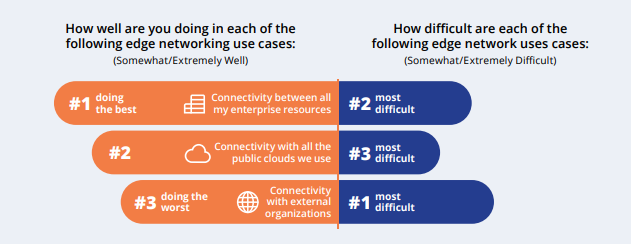Connectivity continues to be top of mind for enterprises today, but ever-increasing demand to provide connectivity to non-enterprise resources, including cloud, reveals existing network edge technologies can’t keep up, according to a new Graphiant State of Network Edge survey.
The enterprise connectivity landscape is spread thin due to remote workers, remote offices and IOT, and this “new normal,” Graphiant pings, is a significant challenge for enterprises.
Outgrowing the edge
Along with enterprise connectivity, cloud connectivity and connecting partners and customers have risen as strong secondary goals for enterprises, according to Graphiant.
While these three cases are important for enterprises — Graphiant expects enterprises to hold all three of equal importance by 2026 — all three edge network use cases were stamped difficult by respondents.

Scale becomes a problem when more cloud and third-party components are introduced in an enterprise, plus, the work-from-home trend fuels the scalability issue even more.
Other growing concerns for enterprises relate to security and privacy as growing amounts of network traffic flows outside enterprise firewalls — plus, the need for IT agility is more important than ever, said Graphiant. This is especially crucial for enterprises moving to a service economy footing.
Is there a future of (network) edge?
The top three edge technologies used by enterprises are SD-WAN, multi-protocol label switching (MPLS), and multi-cloud, according to Graphiant. Yet, respondents rated MPLS poorly overall and failed multi-cloud solutions across all parameters — making it clear existing network edge technologies fail to meet a modern enterprise’s demands.
How enterprises choose to build their network edge is changing as a result of this. Many aspects of enterprise computing have shifted to “as-a-service” — nearly all enterprises have “adopted as their standard” software-as-a-service.
“Nobody wants to sell a product anymore. Everybody wants to sell a service. They want a recurring revenue model and to do that you need a constant relationship with your customer,” said Graphiant’s Matt Krieg, vice president of sales and marketing. “And when you look at enterprises and when you look at business to business (B2B) sales, what does that mean?”
This is where network-as-a-service is introduced with Graphiant’s Network Edge — “Instead of building bespoke networks using decades-old technology, enterprises simply click to configure and consume the network as-a-service,” according to Graphiant.
Still, network-as-a-service is immature in the as-a-service game.
“Network-as-a-service really hasn't seemed to have taken off, so we drill down on that with the enterprise as well,” added Krieg. “Interestingly, seven out of eight said within three years, it's something enterprises said that they were ready for and would look at consuming.”
